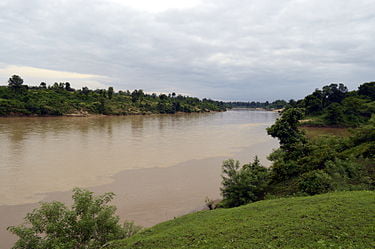Son River

Son River (Hindi: सोन नदी, also spelt Sone River) is a perennial river located in central India. It originates near Amarkantak Hill in Annupur district of Madhya Pradesh and finally merges with the Ganges river near Patna in Bihar. Sone river is the southern and second-largest tributary of the Ganges’ after Yamuna River. India’s oldest river bridge Koilwar Bridge over Sone river connects Arrah with Patna.
The Kabra khurd is a beautiful place on the banks of the Son river, primarily due to its picnic spots.
Sone or Son River is called ‘सोन / सोने’ in Hindi, but called ‘शोण’ in Sanskrit, a rare instance of an Indian river having masculine name. Damodar and Brahmaputr also have masculine name. The Sone originates near Amarkantak in Anuppur district of Madhya Pradesh,[2] just east of the headwater of the Narmada River, and flows north-northwest through Shahdol district in Madhya Pradesh state before turning sharply eastward where it encounters the southwest-northeast-Kaimur Range. The Sone parallels the Kaimur hills, flowing east-northeast through Uttar Pradesh, Jharkhand and Bihar states to join the Ganges just west of Patna. Geologically, the lower valley of the Son is an extension of the Narmada Valley, and the Kaimur Range an extension of the Vindhya Range. Anuppur, Chopan, Deori, Rohtasgarh, Dehri, Sonbhadra and Bihta are the major cities situated on Sone River.
The Sone river which is 784 kilometres (487 mi) long, is one of the longest Indian rivers.[2] Its chief tributaries are the Rihand, Kanhar and the North Koel. The Son has a steep gradient (35–55 cm per km) with quick run-off and ephemeral regimes, becoming a roaring river with the rain-waters in the catchment area but turning quickly into a fordable stream. The Son, being wide and shallow, leaves disconnected pools of water in the remaining parts of the year. The channel of the Son is very wide (about 5 km at Dehri) but the floodplain is narrow, only 3 to 5 kilometres (2 to 3 mi) wide. The meeting point with North Koel the width of Sone River is 5 to 8 kilometres (3 to 5 mi). In the past, the Son has been notorious for changing course. As it is traceable from several old beds near its east bank, the river changed its course more than 5 times. In modern times this tendency has been checked with the anicut at Dehri, and now more so with the Indrapuri Barrage.
